

Design Thinking 2.0 – LEAN Prototyping will be the New Way to Design for IOT. I believe we are ready to test drive new type of Design Thinking powered by LEAN Prototyping consisting of Visualization, Business Analytics, Crowd Sourcing, Gamification, and KickStarter type vendor relationships.

In past blogs, I have communicated that the current incarnation of Design Thinking needs to be restructured in order to be of value as a repeatable design approach. Here I will layout how this new approach will work. First, let’s look at the problem statement in front of us: How will designers apply their specific contributions to the world of IOT? Good design will be defined in the following attributes: Design goals will include: • Achieve hardware standardization through software-based customization • Enable personalization • Incorporate the ability to support ongoing product upgrades • Enable predictive, enhanced, or remote service. Believe or not, the answers to a new Design Paradigm can be found in approaches and lessons learned in the manufacturing of automobiles. 1. 2. Tips on designing for the Internet of Things.
“Really two things,” said Gil Reiter, strategic marketing manager for the Internet of Things at Texas Instruments.
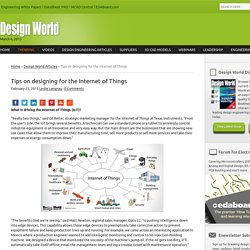
“From the user’s side, the IoT brings several benefits. A technician can use a standard phone or a tablet to wirelessly control industrial equipment in an innovative and very easy way. But the main drivers are the businesses that are showing new use cases that allow them to improve their manufacturing time, sell more products or sell more services and take their expenses or energy consumption down.” “The benefits that we’re seeing,” said Matt Newton, regional sales manager, Opto 22, “is pushing intelligence down into edge devices. Designing For The Internet Of Things.
Treffyn Koreshoff - IxD for the IoT. Treffyn Koreshoff - Internet of things. CHI 2014: Scott Jenson Talks About the Internet of Things. Scott Jenson’s Closing Keynote #CHI 2014 This is the second blog post about CHI 2014 keynote presentations in Toronto.
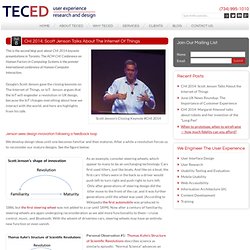
Video: UX for the Internet of Things - MindTheProduct. Interact2011 - Designing Inter-usable Systems. The Everyday Carry Manifesto. Building iPhone apps for the ‘Internet of Things’? Here’s how to get prepared. What exactly is the “Internet of Things”?
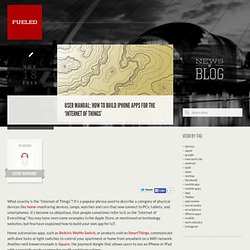
It’s a popular phrase used to describe a category of physical devices like home-monitoring devices, lamps, watches and cars that now connect to PCs, tablets, and smartphones. It’s become so ubiquitous, that people sometimes refer to it as the “Internet of Everything.” You may have seen some examples in the Apple Store, or mentioned on technology websites, but few have explained how to build your own app for IoT. Home automation apps, such as Belkin’s WeMo Switch, or products sold on SmartThings, communicate with door locks or light switches to control your apartment or home from anywhere on a WiFi network. Another well known example is Square, the payment dongle that allows users to use an iPhone or iPad with a specially made scanner for credit card transactions.
Ryan Matzner is the Director of Strategy at Fueled, a development agency in New York City and London that builds mobile apps and web products. An Easy Internet of Things Interface. With the advent of the Internet of things, potentially billions of devices will report data about themselves, making it possible to create new applications in areas as diverse as factory optimization, car maintenance, or simply keeping track of your stuff online.
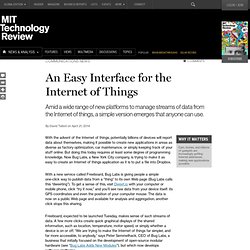
But doing this today requires at least some degree of programming knowledge. Now Bug Labs, a New York City company, is trying to make it as easy to create an Internet of things application as it is to put a file into Dropbox. With a new service called Freeboard, Bug Labs is giving people a simple one-click way to publish data from a “thing” to its own Web page (Bug Labs calls this “dweeting”). To get a sense of this, visit Dweet.io with your computer or mobile phone, click “try it now,” and you’ll see raw data from your device itself: its GPS coordinates and even the position of your computer mouse.
Slides for “Designing for the Internet of Things” at HOW Design Live 2014. By David Sherwin - May 14, 2014 Off the Page Into the Wild: Designing For the Internet of Things from frog We no longer live in a disconnected world.
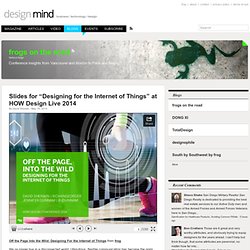
Ubiquitous, flexible communication has become the norm. We are living in huge device ecosystems, whose complexities are increasingly challenging to perceive. The Internet of Things calls for a new approach to design. Img - Google I/O connected ecosystem. The User Experience of the Internet of Things. 30k Ft: Interaction Design within the Internet of Things. What is “Smart”? User Experience and the Internet of Things. In the developed world we’ve achieved 100% connectivity for humans and are working on connecting-up all the “things” around us too, offering the tantalising prospect of the Internet of Things – a world where autonomous devices get on with the business of making the world a better place, without needing too much attention from us.
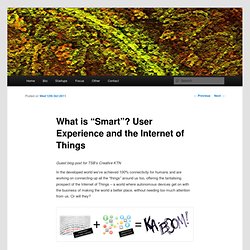
Or will they? Gen Y is wise to technology’s dark side. In the face of ever-expanding device feature-lists, the success of Apple products shows that many consumers now prize usability and simplicity above mere features. We are gadget-rich and time-poor. People, Ubiquity, and the Internet of Things: The New Mobile Context. By Steven Hoober and Mudassir Azeemi Published: January 13, 2014 “We like to distinguish between the environmental and situational contexts of people regardless of the device. … Interactions in all … contexts are important….”
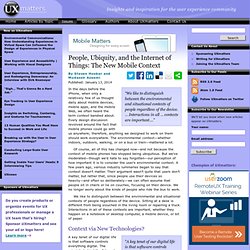
In the days before the iPhone, when only a relatively few of us thought daily about mobile devices, mobile apps, and the mobile Web, we often heard the term context bandied about. Every design discussion revolved around the fact that mobile phones could go with us anywhere; therefore, anything we designed to work on them should work everywhere. The environmental context—whether indoors, outdoors, walking, or on a bus or train—mattered a lot. Wear. Say “Ok Google” to ask questions and get stuff done.
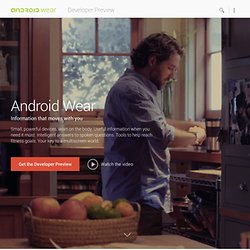
Get glanceable, actionable information at just the right time throughout the day. A wide range of sensors is available to your applications, from accelerometers to heart rate monitors. The Android Wear Developer Preview lets you create wearable experiences for your existing Android apps and see how they will appear on square and round Android wearables. Later this year, we’ll be launching the Android Wear SDK, enabling even more customized experiences. Behavior Design — UX / UI Design. Six Requirements of Your First IoT Project. The Internet of Things, the Internet of Everything, the Industrial Internet — whatever you call it, connected devices are a fantastic gift to any business that wants to get closer to their customers.
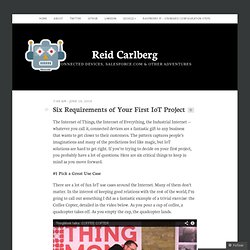
The pattern captures people’s imaginations and many of the predictions feel like magic, but IoT solutions are hard to get right. If you’re trying to decide on your first project, you probably have a lot of questions. Here are six critical things to keep in mind as you move forward. #1 Pick a Great Use Case. Building Effective User Experiences for #IoT – mPortal. The Internet of Things (IoT) has become more than a buzzword – it’s now a reality that owes a significant debt to mobile. But OS design for IoT continues to be a challenge. Uniformity of design and an emphasis on ease of use has been a major factor behind mobile’s success. Ease-of-use has been a hallmark of mobile OS design, along with a consistent UI between different iOS and Android devices.
This has bred customer loyalty and an ingrained sense of what today’s OS’s should entail – intuitive interfaces and simple controls, yet highly functional. Designing for Wearable Technology — User Experience Research. Wearable technology is more than just crap on your wrist, and more than the typical rectangular screen. We are obsessed with the visual, but wearable technology is so much more than what you see. How do we design these objects, challenging the norms while still keeping the end user in mind?
We’re starting to mash up user experience and industrial design to create new skill sets for this booming tech movement. So what are you talking about? Internet of Things: the next frontier for UX? For Wearable Tech Brands, a Lesson from EVs in Drive to Mass Adoption. Pdf - Cross platform service user experience. No to NoUI – Timo Arnall. ‘The best design is invisible‘ is the interaction design phrase of the moment. The images above are from my ever-expanding collection of quotes about how design and technology will ‘disappear‘, become ‘invisible‘ or how the ‘best interface is no interface‘.
The Verge has recently given both Oliver Reichenstein and Golden Krishna a platform to talk about this. This has spawned manifestos, films, talks, books, #NoUI hashtags and some debates about what it might mean. Design and the Coming Iceberg. By Mark Rolston - September 9, 2013 I am a product designer. I have been part of frog for nearly 20 years. In that time I have seen our industry change quite a bit—yet it is nothing like the changes I see coming. 8 Insights About The Coming Era Of Interactive Design. It’s all moving so quickly. Just yesterday, we were amazed by the miracle of making calls from our cars. Now we’re furious when our 4G cuts out while streaming an HD video on a four-inch touch screen, just because we’re 50 feet underground riding the subway.
Branded Interactions. One or two key functions. Well designed apps master their core interactions. Design's Next Big Frontier? Shaping Behavior In Real Time. Other than Michael Bay's already legendary meltdown, the hottest topics of discussion at this year's Consumer Electronics Show are largely wearable and connected. In part, this is just an outcome of consumer expectations: a wearable device is the next step smaller than a smartphone, and we now have the tiny technology to make it work.
But after a long morning examining smart bracelets, smart watches, smart headgear, and smart sporting goods on the CES show floor, it’s clear that there’s a much deeper potential hidden in the cracks. This is because small devices with embedded intelligence can do more than just measure; they’re showing their potential to change the way we act.